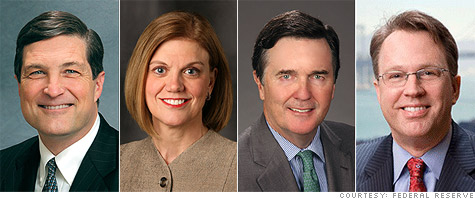
The new voting members of the FOMC: Federal Reserve presidents Jeffrey Lacker of Richmond, Sandra Pianalto of Cleveland, Dennis Lockhart of Atlanta,and John Williams of San Francisco.
NEW YORK (CNNMoney) -- It's a new year. And that means a new, and probably less divided, Fed.
The Federal Reserve is playing its annual game of musical chairs, rotating voting members on its policymaking committee.
While the Fed board of governors and the president of the New York Federal Reserve always have votes, the other Fed presidents take turns serving on the committee.
This time around, the rotation brings on four voting members who are likely to be a far less contentious group than the four they are replacing.
The Federal Open Market Committee's new roster includes presidents Jeffrey Lacker of Richmond, Sandra Pianalto of Cleveland, Dennis Lockhart of Atlanta and John Williams of San Francisco.
All but Lacker are considered either moderates or inflation doves, meaning they're more likely to favor stimulative policies that promote economic growth, even at the risk of higher inflation.
That stands in stark contrast to last year's voting Fed Presidents, three of whom were considered inflation "hawks." Fearing monetary stimulus could send prices rising too rapidly, they each dissented twice against the Fed's policies.
Meanwhile, Charles Evans, the lone dove on last year's team, worried the Fed wasn't doing enough to bring unemployment down, and also dissented a couple times.
Altogether, that group made Fed history. Never before had all four rotating voters cast dissents in the same year.
With those members out of voting roles this year, the leanings of the new team could open the door to more stimulative policies, say some experts.
"What you'll have is possibly a less divisive FOMC and a little more chance for stronger consensus building among the members," said Ellen Zentner, senior U.S. economist at Nomura. "That makes everything easier."
The main conundrum facing the Fed last year remains on the table: How can the central bank help bring the unemployment rate down, without triggering a rapid rise in prices?
On one hand, data on the economy has been improving lately. Hiring seems to have picked up at the end of 2011. The unemployment rate fell and inflation has moderated.
On the other hand, the recovery still has a long way to go. Fed members have recently spoken in favor of more accommodative monetary policy, in particular, to boost the struggling housing market.
Ideas being thrown around include announcing an explicit inflation target -- a move that would likely result in more agreement on just how much inflation will be tolerated.
Additional asset purchases designed to inject more money into the economy have also been discussed, building upon the Fed's two rounds of quantitative easing, totaling $2.3 trillion.
For many Fed watchers, it's a matter of when -- not if -- the central bank will announce such a plan. That said, most don't expect a third round of easing -- or QE3 -- to be announced at the upcoming meeting on Wednesday.
"We suspect that the Fed will probably wait another few months before introducing QE3, but it is a close call," notes Paul Ashworth, chief North American economist for Capital Economics.
The looming task at hand is how to interpret a new onslaught of data. For the first time ever, the Fed will release forecasts for its key interest rate, as part of a general effort to increase the central bank's transparency.
Recently, the Fed has indicated it expects its key interest rate to remain near record lows until at least mid-2013. If the Fed can signal the federal funds rate may stay low even longer than that, the language alone could have a stimulative effect on the economy.
"If the Fed's forecasts push market expectations out beyond 2014, I think they'll deem this a successful meeting," Zentner said. "Pushing expectations further out on the horizon, puts downward pressure on interest rates. This translates directly into low mortgage rates."
The Federal Reserve is expected to release its policy statement at 12:30 p.m. ET Wednesday. Later that afternoon, Chairman Ben Bernanke will hold a press conference and release the Fed's latest forecasts for inflation, unemployment, economic growth and the federal funds rate. ![]()
| Overnight Avg Rate | Latest | Change | Last Week |
|---|---|---|---|
| 30 yr fixed | 3.80% | 3.88% | |
| 15 yr fixed | 3.20% | 3.23% | |
| 5/1 ARM | 3.84% | 3.88% | |
| 30 yr refi | 3.82% | 3.93% | |
| 15 yr refi | 3.20% | 3.23% |
Today's featured rates:
| Latest Report | Next Update |
|---|---|
| Home prices | Aug 28 |
| Consumer confidence | Aug 28 |
| GDP | Aug 29 |
| Manufacturing (ISM) | Sept 4 |
| Jobs | Sept 7 |
| Inflation (CPI) | Sept 14 |
| Retail sales | Sept 14 |